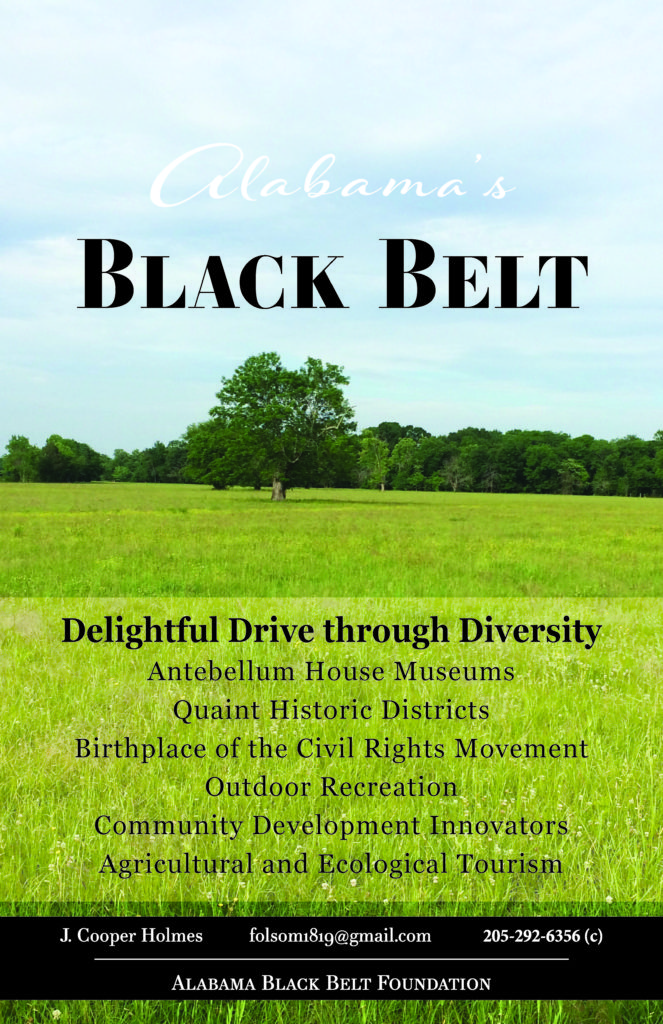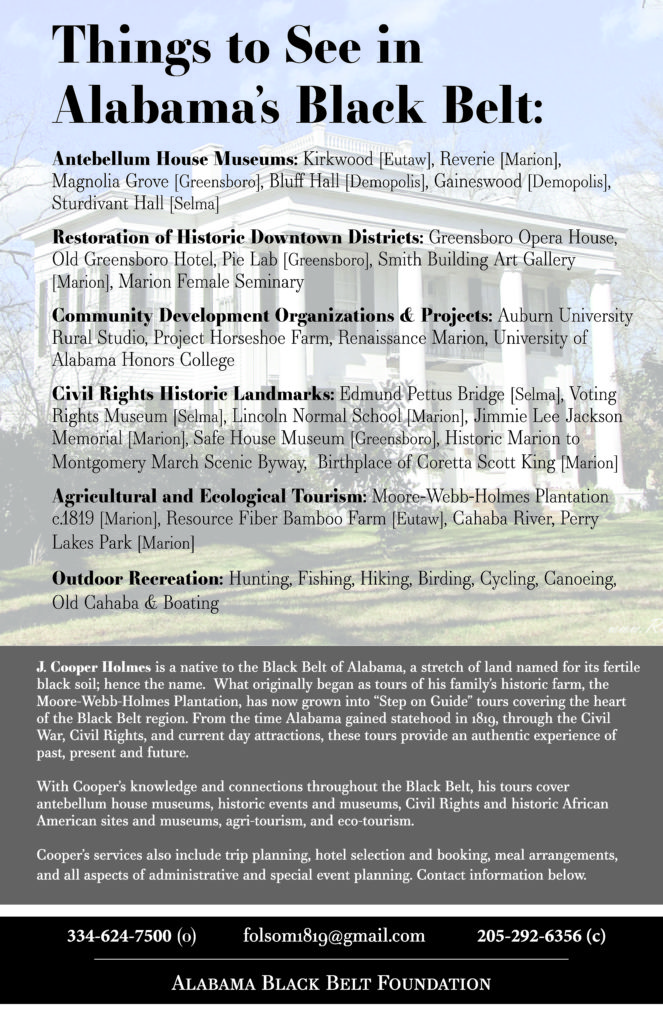Black Belt Itinerary
Marion : The College City
Named after Revolutionary War Hero – Francis Marion
Tour the Courthouse square where Jimmy Lee Jackson was shot which led to Bloody Sunday and the march from Selma to Montgomery.
Marion Military Institute and the Alabama Military Hall of Honor
MMI was founded in 1842 as Howard College what is present day Samford in Birmingham. The Chapel and Old South Barracks served as a hospital during the War Between the States.
Judson College and the Alabama Women’s Hall of Fame
Judson was founded in 1838 as a Christian educational institution for women. It is the fifth oldest women’s college in the country.
Lincoln Normal School and Museum
Established in 1867 by former slaves and in 1885 was voted the top school for freed slaves in the South. Coretta Scott King also graduated Valedictorian here in 1945. Alabama State University traces its roots to this institution.
Female Seminary and Museum
Established in 1836 as a school for girls and built in 1850. Nicola Marshal an art teacher from St. Windel, Prussia was a faculty member here when he designed the Stars and Bars and Confederate Uniform.
Reverie
A Greek Rival built in 1858 by the Whitsitt family. It now serves as a house museum fully furnished with an Empire Period collection.
Coretta Scott King home place and family store
10 miles outside of Marion sits the home and country store where Coretta Scott King grew up and her father ran the family business.
Folsom: Between Marion and Greensboro
Named in honor of Grover Cleveland’s wife Frances Folsom
Moore-Webb-Holmes Plantation c.1819
One of Alabama’s last active plantations operated by the same family with 7 generations on the farm. Tour over 20 historic buildings dating back to the 1820’s including log cotton seed house, cotton gin, gristmill, smoke house, general store and many more.
Greensboro: Catfish Capital of Alabama
Named after Revolutionary War general Nathanael Greene
Magnolia Grove
This temple-style Greek Revival home was built in 1840 by the Croom family and later sold to their niece Sallie Pearson Hobson who’s son was Richmond Pearson Hobson a naval hero in the Spanish American War and a U.S. Congressman. The property also includes a detached kitchen and slave quarters that are open to the public for tours.
Noel-Ramsey House
Built between 1819-1821 by Thomas and Anne Hurtel Noel it is the oldest house in Greensboro. It is also the only surviving house built by the French from the Vine and Olive Colony that is now Demopolis.
Safe House Black History Museum
Rev. Martin Luther King Jr. hiding from the KKK stayed in what is now a museum full of pictures and artifacts from slavery through the Civil Rights Movement. Auburn Rural Studio restored these shotgun houses back to their original 1960’s decor with one being a museum and the other used for classes with a computer lab and art gallery.
The Greensboro Hotel
Believed to have been built in the 1830’s with Flemish bond bricklaying as a two story building and a third story added around 1890. Now under restoration by Horseshoe Farm who will use the upstairs for housing and classroom space for their fellows and downstairs for workshops for the community.
Greensboro Opera House
Built in 1903 a year after the original built in the 1890’s burned. After being vacant for over half a century a group of citizens bought the building which is under renovation to turn it into a multi-purpose cultural center for the community and the surrounding area.
Newbern: Named for the town of New Bern, North Carolina in 1854
Auburn Rural Studio
The Rural Studio of Auburn University is based in Newbern; its architecture student practitioners work under the supervision of faculty on designing and building affordable housing and similar projects to support the population of rural areas in Alabama.
Eutaw: Named after Nathaniel Greene’s Revolutionary War Victory at Eutaw Springs, South Carolina.
Kirkwood
A Magnificent Greek Revival with an Italianate influence this is one of the finest Antebellum homes in Alabama and South. Construction started in 1857 and was halted when nearly completed by the War between the States. Restored by the Swayze family in the 70’s and 80’s who were awarded the National Trust for Historic Preservation Honor Award in 1982.
Everhope Plantation B&B
Built in 1852 for Captain Nathan Carpenter and designed and constructed by David Rinehart Anthony who built several plantation homes in and around Eutaw. This classic Greek Revival home is thought to have been built from timber harvested off of the 600 plus acre plantation.
Resource Fiber
RAPIDLY RENEWABLE BAMBOO | Resource Fiber is the only fully integrated bamboo company in the U.S. where they have a nursery, transplant, harvest and manufacture products all in the same place
and is built on the Triple Bottom Line – People, Planet, Profit. Bamboo is a replacement for old growth wood fiber and an alternative to petroleum-based composites.
Demopolis – City of the People
Settled by French expatriates in 1817 as the Vine and Olive Colony
Gaineswood
General Nathan Bryan Whitfield was the owner, builder, and architect, much like Thomas Jefferson at Monticello, for this magnificent mansion that represents three styles of Greek architecture. Implementing Doric- style outside, Ionic for the interior and Corinthian in the drawing room, this house still has many of the original furnishings as well as several of the General’s inventions.
Bluff Hall
Built in 1832 on the White Bluffs by Allen Glover for his daughter and son-in-law who used it as a town home when not on their plantation at Bermuda Hill. It is owned by the Marengo County Historical Commission and operates as a historic house museum, with the gift shop in the old detached kitchen.
Marengo County History & Archive Museum
Located in Historic Downtown Demopolis the Rosenbush building houses this museum that tells the history, culture, and the people of Marengo County and their contributions to society, including the Native American, French, African-American, Jewish, and European communities.
Note that Marion, Greensboro, and Eutaw are all connected by Hwy. 14
Selma is not included in this but can and it is also connected to these towns by Hwy. 14
Eutaw to Demopolis is an easy drive down hwy. 43
All of these towns are about a 20 minute drive from one to the next
Marion has I nice hotel, (Sleep Inn), that has around 60 rooms and Demopolis has several hotels as well as Selma. There also several B&B’s in the area.


You must be logged in to post a comment.